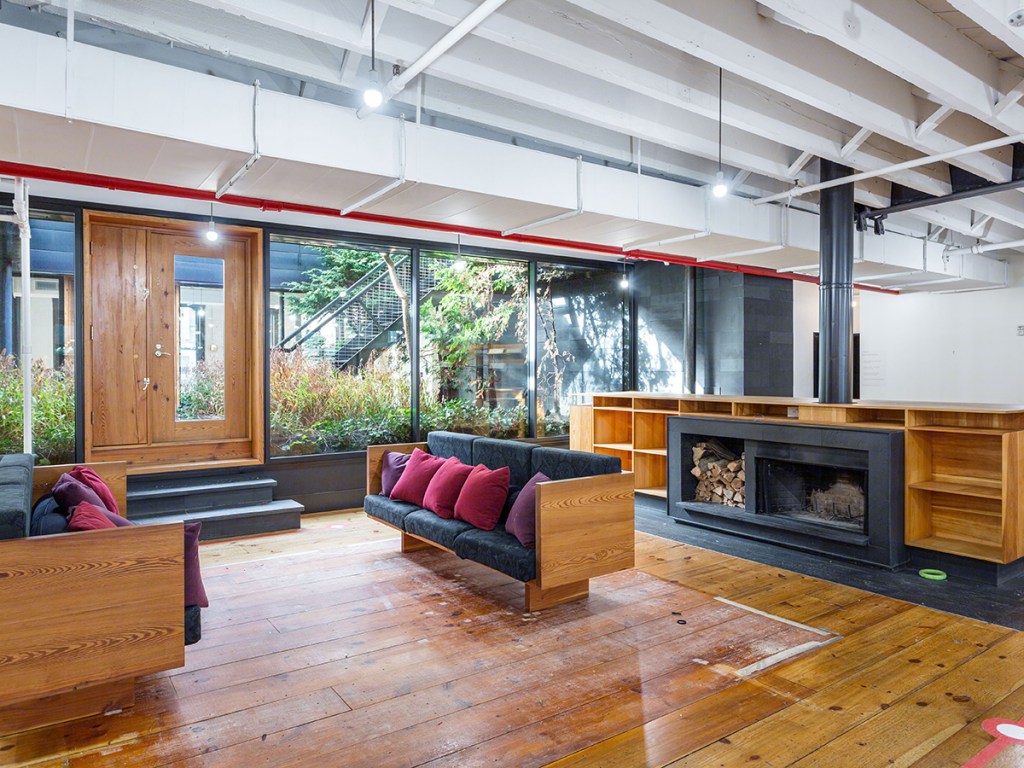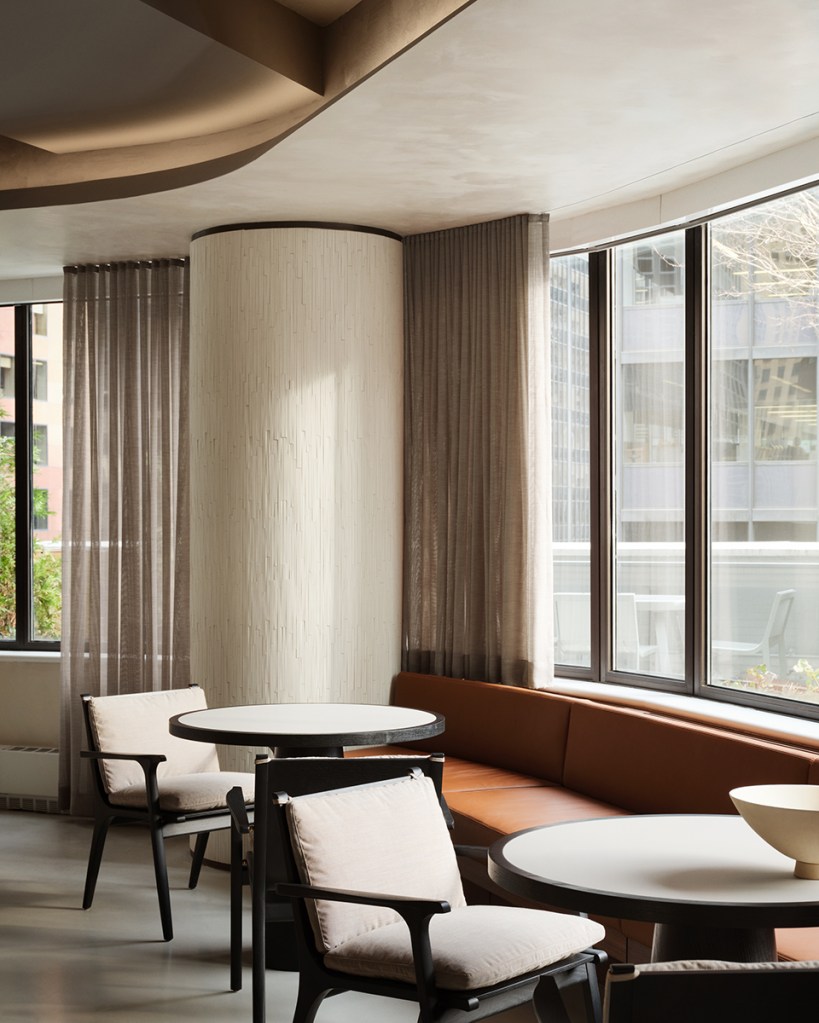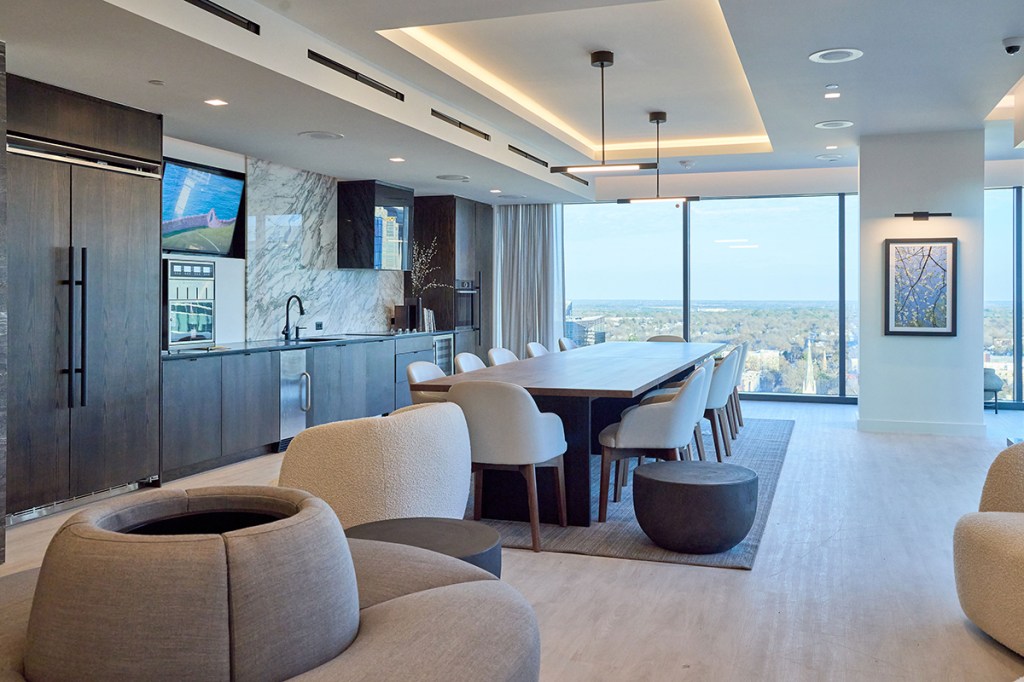Designing an Office Experience That Feels Like Home
To attract tenants, developers and designers are creating more than just a place to work.
Offices have evolved into much more than cubicles and coffee machines. Today, owners, and designers are pushing the envelope on what it means to come the office, and increasingly work needs to feel like home.
“We believe that offices are for living,” said Ankur Patel, associate director of architecture and design, Sage Realty Corp. “Good office space is good living.”
Offices must provide the things that are most important to people–health, wealth and a sense of self, Patel said. In doing so, we remove “office” from our vocabulary and, instead, build spaces that people look forward to inhabiting.

To blur the line between work and everyday life, architects say, the design of spaces such as wellness facilities, cafes and homes are informing the design of office buildings. And the easier owners make it for tenants to tour a building and envision how the team fits into the space the more quickly offices are getting leased.
“Office design and buildout is paramount right now…” said Adam Henick, cofounder, Current Real Estate Advisors. “I am firm believer that the more money owners are spending on the front end, the more they receive in the backend through rent receipts. There is a high degree of correlation there, and a positive one.”
Every aspect of the design of an office space matters, from the finishes to the conference rooms to the appliances to the elevators. And amenities must be impressive.
“Employers are asking if an office can be inspiring and stimulating,” noted Trammell Crow Senior Vice President Woody Coley. “Can employers feel like they have created a competitive advantage for talent with the office choice they have made?” The “food groups” of choice for office tenants include wellness, flexibility, experiential elements and social spaces.

Design as an amenity
The more “typical” office amenities, like a fitness center or a coffee area, influence rental and occupancy rates dramatically. But a finely designed office space can also be an amenity.
“By definition, an amenity is a feature or enhancement,” Coley said. “Office design considers a program of enhancements, working hand in hand with developers to advance the desirability of workplace options to employers and employees.”
Design choices that can directly benefit productivity, pride, comfort, etc. range based on the user type. But frequently, these design choices mean elements that promote and foster a society. This doesn’t just mean at the workspace. Great office design is integrated throughout the entire experience of an office building.
“We at Sage believe that the more seamless the experience is in the life of a building, the heightened overall sense of satisfaction,” Patel said. Every step of the way and each touchpoint that a tenant might encounter is thought out. Even something as simple as matching color pallets to stone detailing throughout a floor can become crucial.
“We think about what feelings we want to evoke in our lobbies and buildings,” he continued. “We think about the original concepts and what the buildings mean and then we think about how to make it modern: Is it open, fluid, spacious, monochromatic or monolithic?”
Crafted amenity spaces, well thought-out gathering rooms, cohesive and adaptable seating elements and spacious seating areas and conference rooms all require their own attention to detail. And designing around natural light and healthy airflow is a must. If design is to be as impactful as an amenity itself, it must be present from the entire floorplan to kitchen cabinet handles.
“A well-designed office that reduces employee pain points and caters to their different needs, whether they are focusing on head-down work or connecting with colleagues or clients, has the potential to increase engagement and productivity,” observed Jonathan Pearce, U.S. head of investments, office and life sciences, for Ivanhoé Cambridge.
In the amenities arms race, office design and functionality are becoming increasingly important considerations.
While Henick wouldn’t classify design as an amenity, he does think its immensely impactful. “If the office functionality and design doesn’t exist, the amenities don’t matter,” he said.

“We” instead of “me”
One trend that seems ubiquitous for office tenants today is design for the greater good. Whereas previous office design was often senior executive-centric, the emphasis has shifted towards a collaborative workspace.
“Over the past decade, the emphasis of ‘me space’ or private offices has declined, with new emphasis on ‘we’ space designed to foster collaboration,” Coley said. “Open office plans with high ceilings were combined with huddle rooms and more interior social spaces within office designs.”
Hybrid work and work from home have highlighted the importance of interaction in the office. While function and comfort have always been priorities, collaboration is now taking center stage.
“Tenants seek spaces that not only facilitate work but also inspire collaboration, creativity, and community, transforming the office into a vibrant hub where employees can converge and engage,” Pearce noted.
The ratio of individual workstations to collaborative shared seating is closer to a 1:1 correlation, Henick said.
Experiential amenities persist
In the great amenities race, experiential amenities are still in, but not in the way that some might think.
“There are a number of amenities that are appealing and compelling, but the actual utilization is perhaps lesser than some would think,” Henick said.

Often people think of pickleball courts and yoga classes when they think of an experiential amenity. However, experiential is more broadly defined today as those things that enhance the space and the overall experience. An onsite team that knows the names of the tenants in the building and offers the same familiar “good morning” is as much of an experiential amenity as a meditation class is. When done correctly, experiential elements are proven to increase productivity, satisfaction and tenant retention.
“(Experiential activity) is kind of how we gauge everything in our lives, so why wouldn’t it come into play in your office space…?” Patel said, noting that Sage has a whole team that is dedicated to member experience. “Designing around experience is not just a trend for today. It’s something that’s integral to how you design overall.”
It is in the experiential realm where office borrows from the hospitality and event fields. And the experiential can impact those working remotely as well, Pearce added. Experiential activity within the office is a trend that has staying power, but with some modifications to fit today’s hybrid work models…” he said.
“This is done through putting a greater emphasis on the incorporation of technology-driven experiences to facilitate that engagement and connectivity among dispersed teams, combined with hospitality features that foster human connection.”
Striking a balance
With stellar amenities the new normal, additional benefits become critical. “Because so many buildings have added amenities over the last few years, even those are becoming commoditized,” Henick said. “So, it’s about how buildings can separate themselves in other ways.”
For each tenant, this is going to be something different, Henick noted. For a tech client, open layouts are highly attractive. But for a law firm, a healthy amount of private meeting spaces and individual workstations are the priority.
“Placing the end users’ needs at the heart of the conversation when conceptualizing a space is the key to optimizing both amenity design and overall functionality,” Pearce said.
Therefore, instead of focusing on a single feature or amenity, developers and designers must concentrate on offering a whole package of tangible and intangible amenities.
“Before the amenities matter, the building engineer needs to arrive early and have building temperatures acceptable,” Coley said. “Security needs to arrive punctually to greet each occupant by name. Janitorial must have done a flawless job the night before to prepare public and private spaces immaculately for each day. The barista in the building coffee shop has to remember if you prefer almond milk or half and half.”







You must be logged in to post a comment.